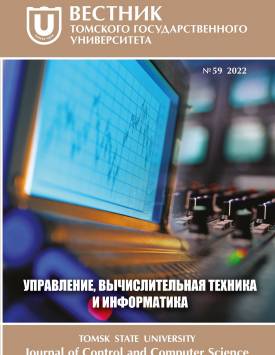Algorithm for finding an approximate solution of the problem of optimal control of a chemical process in the presence of terminal restrictions
The article is devoted to the development of a numerical algorithm for finding an approximate solution to the problem of optimal control by a chemical process with terminal constraints. One of the most important tasks of mathematical modeling of chemical processes is the task of determining the optimal conditions for their conduct, as well as the creation of automated complexes for their calculation. The search for optimal methods for conducting chemical processes leads to optimal control problems, including restrictions on phase variables and control parameters, since their permissible values are limited by technological limits. The presence of restrictions on phase variables significantly complicates the search for solutions to optimization problems, including in the course of computer implementation of their numerical methods for finding optimal control. Therefore, the development of algorithms and programs for solving optimal control problems with phase constraints is an urgent problem and is of practical interest. To construct realizable algorithms for solving the optimal control problem with phase constraints, the penalty method is often used. The main idea of this method is to replace a problem with constraints on a problem without constraints by adding a "penalty" to the optimality criterion, the sequence of solutions of which gives a solution to the original problem. It is possible to overcome the difficulties arising from the use of classical optimization methods, such as the nonlinearity of mathematical models of processes, the requirements for the continuity of the objective function and its derivatives, the large dimension of the problem, by using genetic algorithms. Genetic algorithms make it possible to find an approximate solution to the optimal control problem, which is acceptable from a practical point of view. An important advantage of genetic algorithms is the independence of the solution found with their help from the choice of the starting point of the search. Genetic algorithms can be easily modified for different processes and tasks by changing the number of phase variables and control parameters. The article formulates a general formulation of the optimal control problem for a chemical process with constraints on the control parameter and phase variables. To solve it, a step-by-step algorithm is described, the operation of which is based on two methods: the method of penalties and the genetic algorithm. Using the penalty method, the original problem with terminal constraints is reduced to a problem without constraints on the phase variables. The resulting new optimal control problem with a new optimality criterion is solved using a genetic algorithm. This algorithm is implemented as a software tool in the Delphi visual programming environment, which allows the user to configure the parameters of the penalty method and the genetic algorithm. The algorithm was tested on the example of the aminomethylation reaction of thiols. The formulation of the problem of finding the optimal temperature regime for a given reaction with restrictions on the control parameter (reaction temperature) and terminal restrictions (selectivity of formation of the target substance, conversion of substances) is formulated to determine the maximum yield of the reaction product. The suboptimal temperature regime and the corresponding concentrations of substances at which the terminal restrictions are fulfilled have been calculated. The values of the selectivity of the target reaction product, the conversion of substances, and the values of the optimality criterion at some permissible temperature values are given. It is shown that the suboptimal concentration of the target substance calculated using the algorithm exceeds the values of its concentrations determined under other temperature conditions. Contribution of the authors: the authors contributed equally to this article. The authors declare no conflicts of interests.
Keywords
optimal control problem, terminal restrictions, penalty method, genetic algorithms, thiol aminomethy-lation reactionAuthors
| Name | Organization | |
| Antipina Evgenia V. | Bashkir State University | stepashinaev@ya.ru |
| Mustafina Svetlana A. | Bashkir State University | mustafina_sa@mail.ru |
| Antipin Andrey F. | Bashkir State University | andrejantipin@ya.ru |
References

Algorithm for finding an approximate solution of the problem of optimal control of a chemical process in the presence of terminal restrictions | Vestnik Tomskogo gosudarstvennogo universiteta. Upravlenie, vychislitelnaja tehnika i informatika – Tomsk State University Journal of Control and Computer Science. 2022. № 59. DOI: 10.17223/19988605/59/1
